

LANGUAGE AND IDENTITY
![]()
 |
|||||
 |
|||||
LANGUAGE AND IDENTITY |
|||||
|
|||||
|
|
|
|
|
|
|
|
The language of the Inari Sámi, the Inari Sámi language, is one of the most endangered of all Sámi languages. There are several reasons for this condition. It is the only Sámi language that is spoken only in Finland. So, all Inari Sámis speak Finnish too. The transfer of the language of the family to Finnish happened earlier than other Sámi groups, perhaps for historical reasons. The settlement of Finns and the arrival of state institutions, such as the church and schools, in the Inari Sámi area occurred at an early date. The closing of the borders in the Nordic countries brought Northern Sámi influence in an even greater measure and the situation of the Inari Sámis as a minority among minorities took shape. In a multicultural environment the population naturally became multilingual. The shift of language often led also to a general reformation of property. The name of the property was registered in Finnish and the family also changed its name even though the means of making a living on the land did not change. The ensuing development after the World Wars brought an abundance of new occupational possibilities. The shift away from traditional livelihoods took with it yet another language environment. The situation of Inari Sámi in the 1990’s was such that the youngest speakers of the language were already teenagers; in other words, the language would die after the passing of a few generations. Own Language an Ethnic Element Inari Sámi, like other Sámi languages, includes a great amount of vocabulary linked to the northern environment and traditional living circumstances which makes it unique and untranslatable into Finnish. Sámi terms for matters related especially to livelihood had already, however, formed a Finnish dialect vocabulary at an early date. The language is anyway the element that best distinguishes the Inari Sámis from other Sámi groups. Means of livelihood – reindeer husbandry, fishing and gathering – are things that unite the Inari Sámis to other Sámi groups. Not even another important ethnic badge of identity, the Sámi costume, necessarily bespoke the identity of its wearer as Inari Sámi, for Inari families in the western and northern parts generally wore the so-called Utsjoki model of costume. With the modernization of the Sámi community, their own language and cultural products related to language occupy an ever more important station in forming ethnic identity. Revitalization of the Language Inari Sámi activists have been able to halt the decrease of speakers by borrowing a New Zealand Maori innovation. Kohanga reo, kielâpiervâl in Sámi, or the Inari Sámi language bath, began functioning in Inari with funding from the Finnish Cultural Treasury in 1997. Small children take part in the language bath, a Sámi language daycare environment, though their parents may not even speak the language. As many as 33 children have attended the language bath as of the moment of the writing of this article. Part of them have continued studies in an Inari Sámi class in school and thereby acquired proficiency akin to a mother tongue. The function of the language bath has however been at risk each year due to the uncertainty of funding and school is plagued by the lack of teaching staff. The language bath has had a great influence in both the birth of new language speakers and a renewed interest in Inari Sámi through the children. Many a parent has participated in Inari Sámi courses and the language was able to be used in the home, especially when siblings of families participate in the language bath. The influence of the language bath is being presently researched as part of a doctoral dissertation. Language a Part of the Future of the Sámi Identity Personal proficiency in the Sámi language and passing it on to children ensures continuation to the Sámi identity and propagates optimism concerning the future of the culture. The continuation of identity can be caused by other means as well, for example, by the passing on of means of livelihood from one generation to another. Many characteristics related to traditionally Sámi means of livelihood and ways of life nevertheless change and disappear. The language, however, remains as long as new speakers are born into the society. Methods of supporting the Inari Sámi language are therefore possibly the simplest forms of preserving Inari Sámi culture and Inari Sámi ethnic identity. Kaisu Nikula |
| ||||||||||||
| © 2006 Sámi musea Siida & Anarâškielâ servi siida@samimuseum.fi |